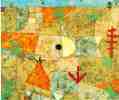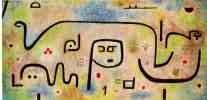Primitive art, surrealism, cubism, and children's art all seem blended into his small-scale, delicate paintings, watercolors, and drawings. Klee grew up in a musical family and was himself a violinist. After much hesitation he chose to study art, not music, and he attended the Munich Academy in 1900. There his teacher was the popular symbolist and society painter Franz von STUCK. Klee later toured Italy (1901-02), responding enthusiastically to Early Christian and Byzantine art.
Klee's early works are mostly etchings and pen-and-ink drawings. These combine satirical, grotesque, and surreal elements and reveal the influence of Francisco de Goya and James Ensor, both of whom Klee admired. Two of his best-known etchings, dating from 1903, are Virgin in a Tree and Two Men Meet, Each Believing the Other to Be of Higher Rank. Such peculiar, evocative titles are characteristic of Klee and give his works an added dimension of meaning.
After his marriage in 1906 to the pianist Lili Stumpf, Klee settled in Munich, then an important center for avant-garde art. That same year he exhibited his etchings for the first time. His friendship with the painters Wassily Kandinsky and August Macke prompted him to join Der Blaue Reiter (The Blue Rider), an expressionist group that contributed much to the development of abstract art.
A turning point in Klee's career was his visit to Tunisia with Macke and Louis Molliet in 1914. He was so overwhelmed by the intense light there that he wrote:
"Color has taken possession of me; no longer do I have to chase after it, I know that it has hold of me forever. That is the significance of this blessed moment. Color and I are one. I am a painter."He now built up compositions of colored squares that have the radiance of the mosaics he saw on his Italian sojourn. The watercolor Red and White Domes (1914; Collection of Clifford Odets, New York City) is distinctive of this period.
Klee often incorporated letters and numerals into his paintings, as in Once Emerged from the Gray of Night (1917-18; Klee Foundation, Berlin). These, part of Klee's complex language of symbols and signs, are drawn from the unconscious and used to obtain a poetic amalgam of abstraction and reality. He wrote that "Art does not reproduce the visible, it makes visible," and he pursued this goal in a wide range of media using an amazingly inventive battery of techniques. Line and color predominate with Klee, but he also produced series of works that explore mosaic and other effects.
Klee taught at the BAUHAUS school after World War I, where his friend Kandinsky was also a faculty member. In Pedagogical Sketchbook (1925), one of his several important essays on art theory, Klee tried to define and analyze the primary visual elements and the ways in which they could be applied. In 1931 he began teaching at Dusseldorf Academy, but he was dismissed by the Nazis, who termed his work "degenerate." In 1933, Klee went to Switzerland. There he came down with the crippling collagen disease scleroderma, which forced him to develop a simpler style and eventually killed him. The late works, characterized by heavy black lines, are often reflections on death and war, but his last painting, Still Life (1940; Felix Klee collection, Bern), is a serene summation of his life's concerns as a creator.
Photographs by Mark Harden.
 1914
1914
 Red and White Domes
Red and White Domes
 Remembrance of a Garden
Remembrance of a Garden
 Southern (Tunisian) Gardens
Southern (Tunisian) Gardens
 Dream City
Dream City
 Ancient Sound, Abstract on Black
Ancient Sound, Abstract on Black
 Highway and Byways
Highway and Byways
 Southern Gardens
Southern Gardens
 Legend of the Nile
Legend of the Nile
 Insula Dulcamara
Insula Dulcamara
 Park of Idols
Park of Idols
 Embrace
Embrace
 Captive
Captive
Klee died relatively young of a slow and wasting disease, his death horribly mimicked by the death of peace that signified World War II. his last paintings are unlike any of his others. They are larger, with the forms often enclosed by a thick black line, as if Klee were protecting them against a violent outrage. The wit is gone and there is a huge sorrow, not personal, but for foolish and wilful humanity.
Death and Fire (1940; 46 x 44 cm (18 x 17 1/3 in)) is one of Klee's last paintings. A white, gleaming skull occupies the center, with the German word for death, Tod, forming the features of its face. A minimal man walks towards death, his breast stripped of his heart, his face featureless, his body without substance. Death is his only reality, his facial features waiting there in the grave for him. But there is fire in this picture too: the sun, not yet set, rests on the earth's rim, which is also the hand of death. The upper air is luminous with fire, presenting not an alternative to death, but a deeper understanding of it. The man walks forward bravely, into the radiance, into the light. The cool, grey-green domain of death accepts the fire and offers wry comfort.
Three mysterious black stakes jag down vertically from above, and the man strikes the skull with another. If fate forces him down into the earth, he does not go passively or reluctantly: he cooperates. Death's head is only a half-circle, but the sun that it balances in its hand is a perfect globe. The sun is what endures the longest, what rises highest, what matters most, even to death itself. Klee understood his death as a movement into the deepest reality, because, as he said, ``the objective world surrounding us is not the only one possible; there are others, latent''. He reveals a little of that latent otherness here.
Thanks to the BMW Foundation, the WebMuseum mirrors, partners and contributors for their support.